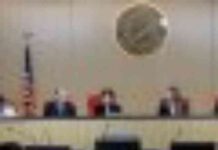(Washington) The path seems increasingly narrow for the Fed: between a gloomy economy and a swaying banking sector, the American central bank, which should announce another rate hike on Wednesday, remains on course to reduce the rate at all costs. ‘inflation.
Its chairman, Jerome Powell, has been saying for months that getting US inflation back to its 2% target will be a long and difficult effort, but a necessary one, because sustained inflation would have even more detrimental consequences for the economy.
There is therefore little chance of seeing the Fed’s monetary committee (FOMC) considering a break right now in its forward march.
Widely anticipated, a moderate hike of a quarter of a percentage point, or 25 basis points, is the widely held assumption among market participants, according to CME Group’s assessment, and while the idea of a pause prevailed at the end of March.
The meeting, which started on Tuesday, resumed on Wednesday “at 9 a.m. as planned”, a Fed spokesperson told AFP.
The decision will be announced in a press release at 2:00 p.m. (2:00 p.m. EST) and then institution president Jerome Powell will hold a press conference at 2:30 p.m. (2:30 p.m. EST). ).
The situation has evolved significantly in recent weeks, in the direction desired by the Fed. While still resisting, the American economy is multiplying the signs of slowing down, long awaited and finally visible.
Last week, first-quarter growth came in at 0.3% from the last three months of 2022 and just 1.1% annualized. And the probability of a recession, more marked than initially expected, is widely anticipated by the markets.
“Our data lead us to believe that the monetary tightening and the recent tensions in the banking system will lead to a slight recession, stronger however than what we had anticipated so far”, underlined the chief economist of Oxford Economics. , Ryan Sweet, interviewed by AFP.
Moreover, the fragility of certain banking establishments came back to the fore with the fall of the regional bank First Republic, finally bought over the weekend by JPMorgan Chase, the number one in the sector.
Concern about the strength of these medium-sized banks remains strong, several of them saw their stocks fall on Wall Street on Tuesday, but recovered on Wednesday.
“Fear was back for the banking sector,” commented Adam Sarhan of 50 Park Investments. “Fear is a very powerful feeling on Wall Street. When he enters through the door, the logic goes out through the window,” he added.
“ The Fed must consider” these banking difficulties “ as a game-changing event ”, affirmed Karl Haeling of LBBW, and no longer consider that the banks bear the brunt of “ isolated cases of mismanagement ”.
Because these banks are suffering in particular from rising rates, which set the day-to-day cost of the money that institutions lend to each other. It has gone in just over a year from a range between 0 and 0.25% to values between 4.75 and 5% now.
The stricter credit conditions for households and businesses “risk slowing down activity and hiring”, warned on April 20 the president of the regional office of the Fed in Philadelphia, Patrick Harker. They can have the same effect as rate hikes, by slowing down demand and therefore the rise in prices, Jerome Powell also underlined during his last press conference.
After this new expected increase, economists will mainly focus on the language of the press release, to find out “ if the reference to “additional firming” is modified ”, estimated Art Hogan of B. Riley Wealth Management.
Many in the markets are hoping that the Fed will declare a pause in observation or at least display less strict communication on the monetary level.
However, while inflation fell sharply in March, core inflation (excluding food and energy prices) barely slowed and is now higher than inflation itself.




